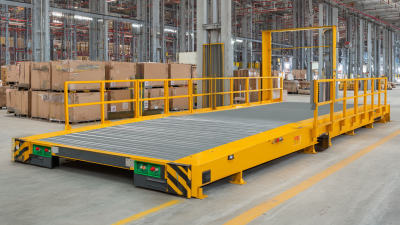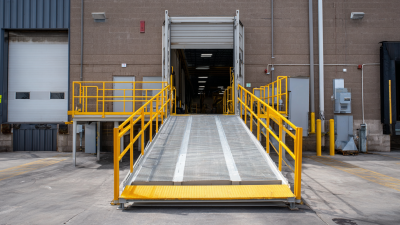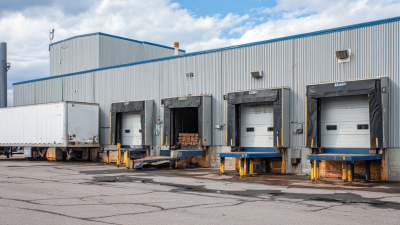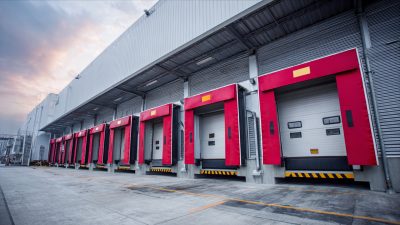In the bustling world of logistics and warehousing, the efficiency of loading and unloading goods can significantly impact a business's overall productivity. Selecting the right loading dock plate, a crucial piece of equipment, can help streamline operations and ensure safety for workers and materials alike. According to industry expert John Smith, a leading authority on logistics solutions, "Choosing the appropriate loading dock plate is vital for seamless operations; it not only improves efficiency but also reduces the risk of accidents."

Understanding the different types of loading dock plates available and their specific applications is essential for businesses seeking to optimize their handling processes. From the lightweight aluminum plates favored for their portability to the heavier steel options designed for demanding industrial environments, each type serves a unique purpose. This guide aims to assist business owners in navigating the complexities of loading dock plates, ensuring that they select the best fit for their operational needs while prioritizing safety and efficiency in their loading dock operations.
When choosing the right loading dock plate for your business, understanding the various types and their applications is crucial. Loading dock plates come in different designs, including movable dock plates, fixed dock plates, and specialty options tailored for specific industries. For instance, adjustable dock plates can accommodate various truck heights, making them ideal for businesses that deal with fluctuating delivery vehicles. Additionally, weight capacity is a significant factor; selecting a plate that can handle your heaviest loads ensures safety and efficiency.
To help with your selection process, consider these tips. First, assess the types of vehicles you regularly receive—some dock plates are specifically designed for forklifts, while others are better suited for hand trucks. Second, determine the frequency of use; a dock plate with a higher durability rating may be necessary for high-traffic areas. Lastly, don't overlook the importance of safety features such as anti-slip surfaces and edge markings to prevent accidents during loading and unloading activities.
Understanding these key factors will guide you in selecting the most effective loading dock plate tailored to your operational needs, ensuring optimal performance in your loading dock area.
When selecting the right loading dock plate for your business, it's essential to consider several key factors that can significantly impact efficiency and safety. Firstly, the capacity of the dock plate is crucial. According to the Industrial Truck Association, improperly chosen dock plates can lead to accidents and equipment damage, with around 35,000 injuries reported annually in the material handling industry. Ensuring that your loading dock plate can support the weight of the loads being transferred will minimize risks and extend the life of your equipment.

Another important aspect to consider is the size and type of the dock plate. The American National Standards Institute (ANSI) recommends carefully evaluating the specific dimensions of both the loading dock and the vehicles used for transport. A well-fitted dock plate will create safer transitions between different surfaces, reducing the chances of slips and falls during loading and unloading processes. Additionally, selecting the appropriate material—whether aluminum, steel, or composite—can enhance durability and reduce maintenance costs, as per findings from Material Handling & Logistics. Making informed choices based on these factors will lead to better operational performance and increased workplace safety.
When selecting a loading dock plate, one of the primary considerations is the material from which it is made. Aluminum and steel are the two most common options, each offering unique benefits that cater to different business needs. Aluminum dock plates are lightweight, making them easy to handle and position. Their resistance to corrosion makes them particularly suitable for environments with moisture or harsh weather conditions, ensuring longevity and reduced maintenance costs. Additionally, aluminum’s natural properties allow it to accommodate lighter loads while still providing adequate strength for various applications.
On the other hand, steel dock plates are known for their exceptional strength and durability. They can handle heavier loads, making them ideal for businesses that frequently move large or heavy goods. While steel plates may be heavier and more prone to rust if not properly maintained, they can often be coated or treated to enhance their resistance to corrosion. Moreover, their robust design can withstand the rigors of daily use in busy loading areas. For companies prioritizing strength and capabilities over weight, steel dock plates provide a reliable solution for heavy-duty operations.

Choosing the right loading dock plate for your business requires careful consideration of both weight capacity and size requirements. The weight capacity is critical, as it determines how much load the dock plate can safely handle. Assessing the maximum weight of the goods you'll be transporting is essential; overloading the plate can lead to accidents, damage, and increased maintenance costs. Manufacturers often provide specifications on the load limits, which should be adhered to in order to ensure the safety of all personnel involved in the loading and unloading process.
In addition to weight capacity, the size of the loading dock plate must fit your specific requirements. This includes the width and length that will accommodate the vehicles and pallets used in your operations. A plate that is too small may not align correctly with the truck or warehouse floor, leading to hazardous situations. Conversely, a loading dock plate that is too large could lead to difficulties in maneuvering, reducing efficiency. It's important to measure the area and consider the dimensions of your typical loading equipment, ensuring that the chosen plate provides a seamless transition between the truck and the dock.
When selecting a loading dock plate for your business, maintenance and safety features should be at the forefront of your decision-making process. Regular inspection and upkeep of the dock plate can significantly extend its lifespan. Ensure that the material used is resistant to corrosion and wear, as this will require less frequent replacements and repairs. Moreover, implementing a routine maintenance schedule, including cleaning and checking for any signs of damage, will help maintain the plate's functionality and reliability over time.
Safety features are equally crucial in ensuring secure operations. Look for dock plates that come equipped with safety edges, which prevent accidents during loading and unloading. Non-slip surfaces can also enhance traction, reducing the risk of slips and falls. Additionally, consider models that include secure locking mechanisms to prevent unintentional movement while in use. By prioritizing these maintenance and safety aspects, businesses can create a safer and more efficient loading dock environment, ultimately safeguarding both goods and personnel.
| Plate Type | Material | Weight Capacity (lbs) | Dimensions (L x W) in inches | Maintenance Features | Safety Features |
|---|---|---|---|---|---|
| Steel Dock Plate | Steel | 5,000 | 48 x 36 | Corrosion-resistant coating | Safety tread surface |
| Aluminum Dock Plate | Aluminum | 2,500 | 60 x 30 | Lightweight and portable | Guardrails and edge protectors |
| Rubber Dock Plate | Rubber | 1,500 | 36 x 24 | Flexible design for uneven surfaces | Anti-slip surface |
| Heavy-duty Dock Plate | Steel | 10,000 | 72 x 48 | Welded construction for durability | Reflective strips for visibility |





